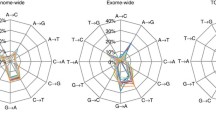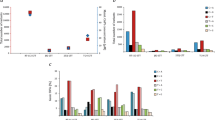Abstract
Homozygous and hemizygous deletions of 9p21 are the earliest and most common genetic alteration in bladder cancer. The identification of two cell cycle regulators, CDKN2 and CDKN2B, that map to the common region of deletion has prompted the hypothesis that they are critical tumor suppressor genes in this malignancy. However, controversy as to whether these genes are the only or even the most important target in bladder cancer oncogenesis remains. To more clearly determine the effect of these 9p21 alterations, we mapped the homozygous deletions and performed a detailed mutational and expression analysis for CDKN2, CDKN2B and a closely linked gene, methylthioadenoside phosphorylase (MTAP), in 16 established bladder cancer cell lines. Nine of the 16 lines exhibit large (30 to >2000 kb) homozygous deletions on 9p21. All deletions include at least one exon of CDKN2, eight of nine include CDKN2B, and six of nine include MTAP. MTAP function correlates with the genomic deletions. SSCP and sequence analysis does not reveal any inactivating point mutations of CDKN2 or of CDKN2B in any of the cell lines without homozygous deletions, and all express the CDKN2 and the CDKN2B mRNA as well as the encoded p16 protein. The p16 protein levels vary widely and are correlated with absent pRb expression. We conclude that the 9p21 deletions in bladder cancer usually inactivate the CDKN2, CDKN2B, and MTAP genes but that CDKN2 is the most common target. Other mechanisms for inactivating this gene in bladder cancer appear to be uncommon.
Similar content being viewed by others
References
Cairns P, Tokino K, Eby Y, Sidranksy D (1994a) Homozygous deletion of 9p21 in primary human bladder tumors detected by competitive multiplex polymerase chain reaction. Cancer Res 54:1422
Cairns P, Mao L, Merlo A, Lee DJ, Eby Y, Tokino K, Riet P, Blaugrund JE, Sidransky D (1994b) Rates of p16 (MTS1) mutations in primary tumors with 9p loss. Science (Washington DC) 265:415
Cairns P, Polascik TJ, Eby Y, Tokino K, Colifano J et al (1995) Frequency of homozygous deletions at p16/CDKN2 in primary human tumors. Nature Gen 11:210
Cheng JQ, Jhanwar SC, Lu YY, Testa JR (1993) Homozygous deletions within 9p21-22 identify a small critical region of chromosomal loss in human malignant mesotheliomas. Cancer Res 53:4761
Dreyling MH, Bohlander SK, Adeyanju MO, Olopade OI (1995) Detection of CDKN2 deletions in tumor cell lines and primary glioma by interphase fluorescence in situ hybridization. Cancer Res 55:984
Fountain JW, Karayiorgou M, Ernstoff MS et al (1992) Homozygous deletions within human chromosome band 9p21 in melanoma. Proc Natl Acad Sci USA 89:10557
Gonzalez-Zuleta M, Shibata A, Ohneseit PF, Spruck CH, Busik C, Shaman M, Elboz M, Nichols PW, Gonzalgo ML, Malmström P-U, Jones PA (1995) Frequent alterations of the p16INK4 locus in squamous cell carcinoma distinguish it from transitional cell carcinoma of the bladder. J Natl Cancer Inst 87:1383
Goodrich DW, Chen Y, Scully P, Lee W-H (1992) Expression of the retinoblastoma gene product in bladder carcinoma cells associates with a low frequency of tumor formation. Cancer Res 52:1968
Hannon GJ, Beach D (1994) p15INK4b is a potential effector of TGF-β-induced cell cycle arrest. Nature 371:257
Kamb A, Gruis NA, Weaver-Feldhaus J, Liu Q, Harshman K, Tavtigain SV, Stockert E, Day RS, Johnson BE, Skolnick MH (1994) A cell cycle regulator potentially involved in genesis of many tumor types. Science (Washington DC) 264:436
Knudson AG (1971) Mutation and cancer: statistical study of retinoblastoma. Proc Natl Acad Sci USA 68:1631
Kwiatkowski K, Diaz M (1992) A dinucleotide repeat in the human IFNA locus. Human Mol Gen 1:658
Liu Q, Neuhausen S, McClure M, Frye C, Weaver-Feldhaus J, Gruis NA, Eddington K, Allalunis-Turner MJ, Skolnick MH, Fujimara FK, Kamb A (1995) CDKN2 (MTS1) tumor suppressor gene mutations in human tumor cell lines. Oncogene 10:1061
Mao L, Merlo A, Bedi G, Shapiro GI, Edwards CD, Rollins BJ, Sidransky D (1995) A novel p16INK4A transcript. Cancer Res 55:2995
Merlo A, Herman JG, Mao L, Lee DJ, Gabrielson E, Burger PC, Baylin SB, Siransky D (1995) 5′ CpG island methylation is associated with transcriptional silencing of the tumour suppressor p16/CDKN2/MTS1 in human cancers. Nature Med 1:686
Miyao N, Tsai YL, Lerner SP, et al (1993) Role of chromosome 9 in human bladder cancer. Cancer Res 53:4066
Mosman T (1983) Rapid colorimetric assay for cellular growth and survival. Application to proliferation and cytotoxicity assays. J Immunol Meth 65:55
Nobori T, Miura K, Wu DJ, Lois A, Takabayashi K, Carson DA (1994) Deletions of the cyclin-dependent kinase-4 inhibitor gene in multiple human cancers. Nature (London) 368:753
Olopade OI, Buchhagen DL, Malik K et al (1993) Homozygous loss of the interferon genes defines the critical region on 9p that is deleted in lung cancers. Cancer Res 53:2410
Olopade OI, Pomykala HM, Hagos F, Sveen LW, Espinosa R III, Dreyling MH, Gursky S, Stadler WM, LeBeau MM, Bohlander SK (1995) Construction of a 2.8 megabase YAC contig and cloning of the methylthioadenosine phosphorylase (MTAP) gene from the tumor suppressor locus on 9p21. Proc Natl Acad Sci USA 92:6489
Perucca D, Szepetowske P, Simon M-P, Gaudray P (1990) Molecular genetics of human bladder carcinomas. Cancer Genet Cytogenet 49:143
Porterfield BW, Pomykala H, Maltepe E, Bohlander SK, Rowley JD, Diaz MO (1993) The use of methylthioadenosine phosphorylase activity to select for human chromosome 9 in interspecies and intraspecies hybrid cells. Som Cell Mol Gen 19:469
Ruppert JM, Tokino K, Sidransky D (1993) Evidence for two bladder cancer suppressor loci on human chromosome 9. Cancer Res 53:5093
Serrano M, Hannon GJ, Beach D (1993) A new regulatory motif in cell-cycle control causing specific inhibition of cyclin D/CDK4. Nature 366:704
Spruck CH III, Gonzalez-Zulueta M, Shibata A, Simoneau AR, Lin MF, Gonzales F, Tsai YC, Jones PA (1994) p16 gene in uncultured tumors. Nature (London) 370:183
Stadler WM, Sherman J, Bohlander SK, Roulston D, Dreyling M, Rukstalis D, Olopade OI (1994) Homozygous deletions within chromosomal bands 9p21-22 in bladder cancer. Cancer Res 54:2060
Tarmin L, Yin J, Zhou X, Suzuki H, Jiang H-Y et al (1994) Frequent loss of heterozygosity on chromosome 9 in adenocarcinoma and squamous cell carcinoma of the oesophagus. Cancer Res 54:6094
Van der Riet P, Nawroz H, Hruban RH, Corio R, Tokino K, Koch W, Sidransky D (1994) Frequent loss of chromosome 9p21-22 early in head and neck cancer progression. Cancer Res 54:1156
Weissenbach J, Gyapay G, Dib C, Vignal A, Morissette J, Millasseau P, Vaysseix G, Lathrop M (1992) A second-generation linkage map of the human genome. Nature (London) 359:794
Yeager T, Stadler W, Belair C, Puthenveettil J, Olopade O, Reznikoff C (1995) Increased p16 levels correlate with pRb alterations in human urothelial cells. Cancer Res 55:493
Xu L, Sgroi D, Sterner CJ, Beauchamp RL, Pinney DM, Keel S, Ueki K, Rutter JL, Buckler AJ, Louis DN, Gusella JF, Ramesh V (1994) Mutational analysis of CDKN2 (MTS1/p16INK4) in human breast carcinomas. Cancer Res 54:5262
Author information
Authors and Affiliations
Rights and permissions
About this article
Cite this article
Stadler, W.M., Olopade, O.I. The 9p21 region in bladder cancer cell lines: large homozygous deletions inactivate the CDKN2, CDKN2B and MTAP genes. Urol. Res. 24, 239–244 (1996). https://doi.org/10.1007/BF00295899
Received:
Accepted:
Issue Date:
DOI: https://doi.org/10.1007/BF00295899




